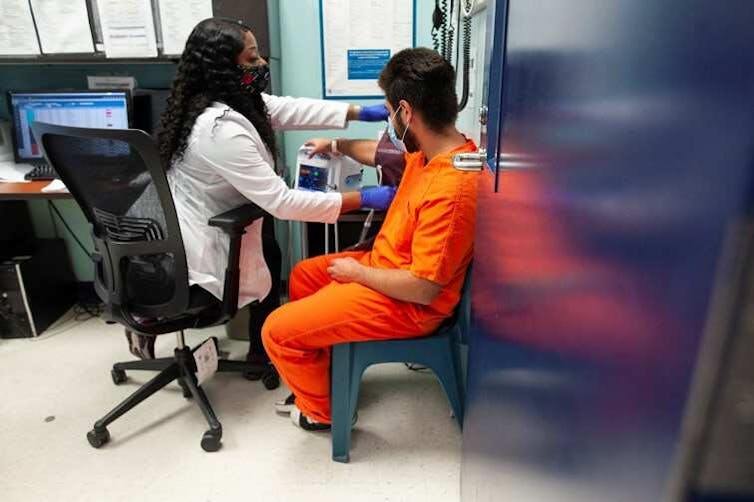The 2024 Homeland Security appropriations bill increased funding for U.S. Immigration and Customs Enforcement operations to handle an anticipated daily detainee population of 41,500, up from an average of 34,000 in recent years.
Yet recent studies have exposed cracks that call into question the agency’s ability to medically care for the detainees it is entrusted with, including inhumane conditions, high suicide rates, structural problems such as the use of prisons to hold detainees, delayed or interrupted medical care and overcrowded conditions. Research also shows that the pandemic years further exacerbated these inequalities.
One recent report by a trio of nonprofit advocacy groups blames preventable deaths of people detained by ICE on inadequate investigations and flawed systems at the agency. The report, Deadly Failures, released on June 25, 2024, by the American Civil Liberties Union, American Oversight, and Physicians for Human Rights, documents inadequacies in diagnosis, treatment and emergency response. It points to suicides that might have been prevented with appropriate mental health care and properly managed medication. And it details underlying issues – understaffing and a lack of interpretation and translation services.
The Conversation asked Cara Buchanan, an emergency physician and clinical fellow in health policy and social emergency medicine at the Harvard Kennedy School, whose research the report cites, about research in this area by her team and others, ICE’s track record on detainee medical care and what needs to be done to improve medical care for people in ICE custody.
What have you and your colleagues found in studying medical care for detainees in U.S. Immigration and Customs Enforcement custody?
Our research shows that preventable deaths of people in ICE detention are often preceded by lapses in a standardized, consistent and competent approach to medical triage, including identification and escalation of the need for emergency care.
What has other recent research uncovered in this area?
Research across many disciplines, including medicine, law, policy, criminal justice, health economics, human rights and public health, correlate structural design features of immigration detention facilities to adverse health outcomes for detainees. This includes the use of solitary confinement, which is linked to an increased risk of self-harm for detainees in ICE custody.
The COVID-19 pandemic highlighted significant health disparities in immigration detention facilities. Many facilities failed to provide adequate basic, preventive and emergency medical care.
Studies also demonstrate a persistent lack of transparent information about conditions in ICE facilities that continues to prompt ongoing calls for increased oversight and accountability to address the systemic sources of poor health outcomes.
The ultimate failure of the immigration detention system to protect the health and safety of detainees is the outcome of preventable death. Publicly available ICE detainee death reports provide basic details about timelines preceding death. However, independent investigations and analyses into the circumstances surrounding these deaths have demonstrated pervasive and systemic negligence.
Billions of dollars of congressional appropriations continue to pour into the expansion of ICE detention facilities, and private prisons contracted to provide services for immigrants in detention report profit margins in the billions of dollars.
How did your work fit with the recently released report?
Deadly Failures expounds on our prior research with a depth and breadth of context.
The report provides clear policy recommendations for major stakeholders – the Department of Homeland Security, the Department of Justice, Congress and local and state governments.
These recommendations range from feasible to ambitious in detailing actions that would eliminate preventable death for those in ICE custody. Proposed interventions include prompt disposition of detainees who have medical and mental health vulnerabilities, limiting the physical and fiscal expansion of detention facilities, investing in community-based services, banning solitary confinement, passing legislation to ensure accountability to standards of care in facility contracts and establishing mechanisms for regular public data reporting. The report also calls for ICE to dismantle the mass immigration detention system at large.
I was particularly heartened to read the second line of the Deadly Failures executive summary, which highlights the most striking finding of our research – the troubling trend of ICE releasing people from custody immediately prior to their deaths.
Why does this happen?
ICE regulations specify that when a detained noncitizen dies in custody, the agency will conduct timely notification, review and publication of the death. But the regulatory language about people who die immediately after release from ICE custody is vague and doesn’t include a reporting timeline or proposed mechanism of accountability for such deaths.
When we investigated the total number of deaths in ICE custody from fiscal years 2021 to 2023, our research team cross-referenced published ICE death reports with news releases issued by investigative journalists and immigration advocacy groups. Our review of public records and available legal documents confirmed four deaths that were not accounted for in the 11 death reports ICE published from those years.
Through this investigation we found a pattern of detainees who, while hospitalized, were released from ICE custody after being deemed critically ill, with death clinically imminent. When we reviewed these detainees’ medical records we found deaths that could have been prevented. In one such case, a detainee contracted COVID-19 while in custody and suffered a series of complications, including multiple hospitalizations for recurrent infections. Concerns raised by the facility medical director about the patient’s persistently critical condition went unaddressed, and after ultimately suffering a stroke the patient was placed on life support. ICE released the unconscious patient from custody just prior to his death. This technical release from custody allowed ICE to avoid mandatory public reporting of this case and its details.
Officially, ICE has said that it is continuing to evaluate its enforcement of health standards and is looking for ways to improve medical care delivery.
Our research team’s key recommendation, also highlighted by the authors of Deadly Failures, is that all deaths of individuals that occur within 30 days of release from ICE custody be included in mandatory public reporting of ICE statistics and death reports. This is a critical measure of transparency and accountability.

What should Immigration and Customs Enforcement be doing to prevent unnecessary deaths on its watch?
Time in ICE custody is related to preventable death. People detained in ICE facilities should be released as quickly as possible so their medical needs can be transitioned to more consistent and long-term care.
Triage should also be standardized. Detainees who show signs and symptoms of serious medical conditions should be rapidly assessed and quickly transferred to local emergency rooms for further evaluation and treatment. Rigorous oversight and accountability should be established for all workers at ICE facilities and for clinical outcomes of detained patients.
Are you still seeking answers to questions you have about detainees? If so, what are you looking for?
ICE’s collection, recording and sharing of high-quality data regarding the capacity of ICE facilities, the scope of health services available and metrics of health outcomes for people detained in ICE custody is markedly limited. The dearth of data leaves a barrage of unanswered questions regarding the conditions that contribute to poor health outcomes. In my view, ICE detention facilities should be held to standards of transparency and accountability to federal and public reporting, as are other large systems of medical care.
Is there anything that has surprised you in what you’ve found over the past few years?
The instances of deficient professional language services, including interpretation and translation, for people detained in ICE custody is surprising. It is at odds with a federal mandate that stipulates a patient’s right to receive health information in their preferred language at no cost. This right is exercised daily in U.S. hospitals and clinics across the country for the nondetained with in-person interpreters or readily accessible technology.

Ultimately, it is disheartening but not surprising that extensive research continues to demonstrate a diminished standard of care experienced by people detained in ICE custody.

The views expressed are the author's own and do not represent the views of Harvard University, Harvard Kennedy School, Harvard Medical School, Mass General Brigham Hospital or any affiliated partners.
Source: The Conversation

 Michigan Gov. Gretchen Whitmer, a potential 2028 candidate, wants to find common ground with Trump
Michigan Gov. Gretchen Whitmer, a potential 2028 candidate, wants to find common ground with Trump
 Biden promised to turn the page on Trump. Now he's being replaced by him
Biden promised to turn the page on Trump. Now he's being replaced by him
 Firefighters prepare for increasing gusts following brief reprieve for LA area
Firefighters prepare for increasing gusts following brief reprieve for LA area
 Nippon Steel wants to work with Trump administration on US Steel deal, Mori tells WSJ
Nippon Steel wants to work with Trump administration on US Steel deal, Mori tells WSJ
 After cable damage, Taiwan to step up surveillance of flag of convenience ships
After cable damage, Taiwan to step up surveillance of flag of convenience ships
 BOJ will raise rates if economy, price conditions continue to improve, Ueda says
BOJ will raise rates if economy, price conditions continue to improve, Ueda says
 Manatees congregate in warm waters near power plants as US winter storms graze Florida
Manatees congregate in warm waters near power plants as US winter storms graze Florida
 AAPI adults prioritize immigration, but split on mass deportations: AP-NORC/AAPI Data poll
AAPI adults prioritize immigration, but split on mass deportations: AP-NORC/AAPI Data poll
 As Los Angeles burns, Hollywood's Oscar season turns into a pledge drive
As Los Angeles burns, Hollywood's Oscar season turns into a pledge drive
 As fires ravage Los Angeles, Tiger Woods isn't sure what will happen with Riviera tournament
As fires ravage Los Angeles, Tiger Woods isn't sure what will happen with Riviera tournament
 Antetokounmpo gets 50th career triple-double as Bucks win 130-115 to end Kings' 7-game win streak
Antetokounmpo gets 50th career triple-double as Bucks win 130-115 to end Kings' 7-game win streak
 The ICE Health Service Corps suffers from outdated systems and a lack of translation services, despite a federal mandate to provide them.
The ICE Health Service Corps suffers from outdated systems and a lack of translation services, despite a federal mandate to provide them.







